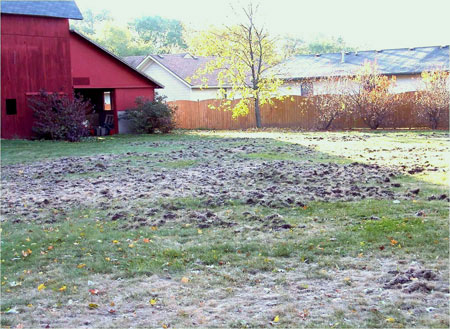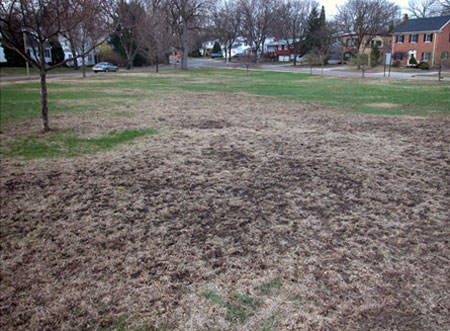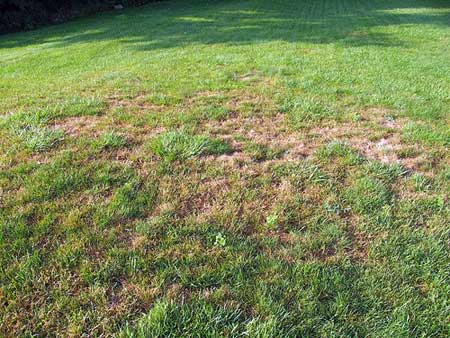Turf damage from grubs and skunks is coming to an end for this spring
European chafer and Japanese beetle grub damage is starting to slow down. Those in southern Michigan should wait until July to apply an insecticide, as grubs are done eating.
European chafer and Japanese beetle grubs have been eating turf roots since March when the soil warmed up rapidly during two weeks of unusually hot weather. When most of the roots are consumed and also when the soil is dry, you may see patches of thin or dead turf, or even bare soil. The dead patches may grow larger each week, from March to late April. The problem becomes worse when skunks or raccoons find the grubs and tear-up the poorly anchored turf for an easy meal.

Fall grub and skunk damage in DeWitt, Mich.
If you suspect a grub problem in your lawn, dig up a few squares of turf, including the top 2 to 3 inches of soil under them, around the edges of the damaged areas and look for c-shaped white grubs. If grubs caused visible damage to your lawn, you won’t have any trouble finding them.

Spring grub damage in Detroit.
At this point, it is better to wait until July to apply an insecticide for grubs because most of the European chafer grubs are done eating and have begun to move deeper into the soil to pupate. However, if you live in the northern Lower Peninsula or in the Upper Peninsula, grub damage may continue for another two weeks. Spot-treating the infested areas with Sevin (carbaryl) or Dylox (trichlorfon) may slow down the grubs and damage from skunks and raccoons, but other turf insecticides will not work at this time. For more information on selecting the right products to stop or prevent grub damage, and the correct time to apply them, see the home lawn grub control section at turf.msu.edu.

Fall grub damage in British Columbia. Photo credit: Jason Hooper
For most homeowners, grub damage can be prevented by raising the mowing height on your lawn mower to the highest setting (usually about 3.5 inches), fertilizing modestly, and watering during dry periods. This promotes a much larger root system under your turfgrass, making your lawn much more tolerant of feeding injury from hungry grubs. The exceptions are the rare cases where grub and skunk damage are so severe that you have large patches of dead turf or bare soil. In that case, I suggest that you use one of the most effective grub control products (see turf.msu.edu) each year in July for two years until you have re-established a healthy lawn with a dense mass of roots under it.
Dr. Smitley's work is funded in part by MSU's AgBioResearch.



 Print
Print Email
Email




